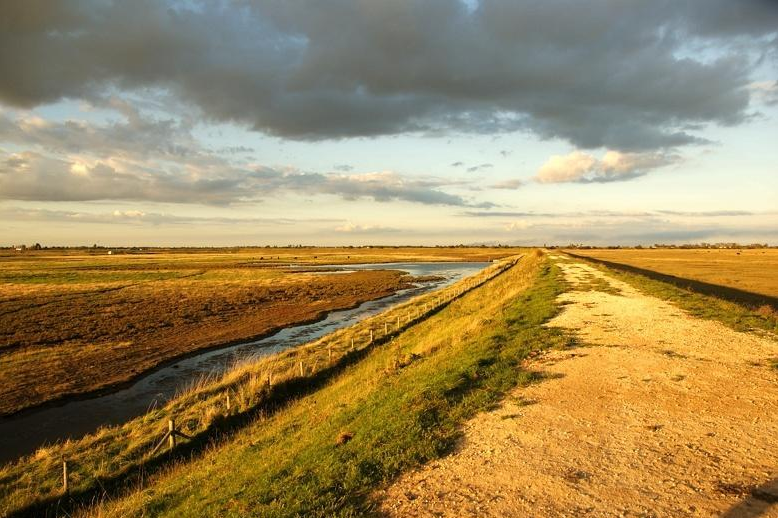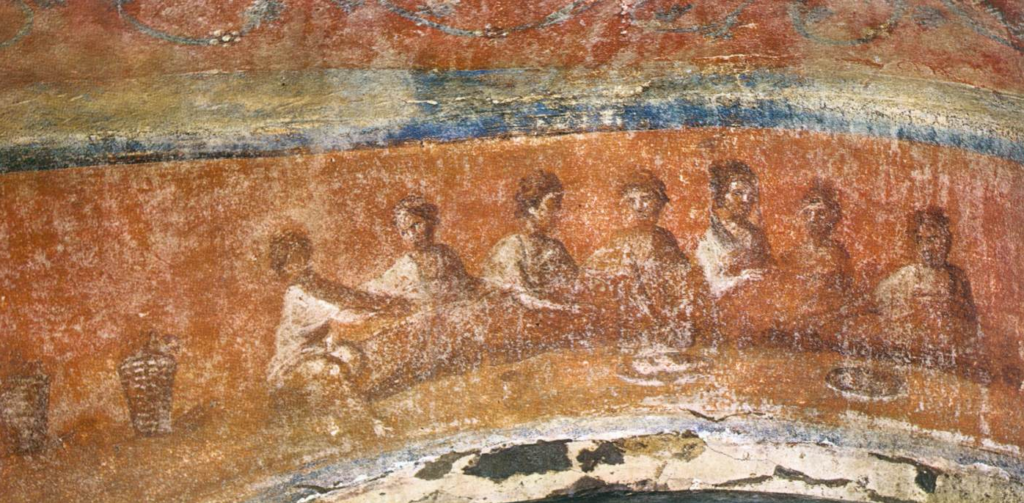Editor’s note: The following is extracted from Hills and the Sea, by Hilaire Belloc (published 1906).
The town of Wisbeach is very like the town of Boston. It stands upon a river which is very narrow and which curves, and in which there rises and falls a most considerable tide, and which is bounded by slimy wooden sides. Here, as at Boston, the boats cannot turn round; if they come in frontways they have to go out backwards, like Mevagissey bees: an awkward harbour.
As I sat there in the White Hart, waiting for steak and onions, I read in a book descriptive of the place that a whale had come to Wisbeach once, and I considered that a whale coming up to Wisbeach on a tide would certainly stay there; not indeed for the delights of the town (of which I say nothing), but because there would be no room to turn round; and a whale cannot swim backwards. The only fish that can swim backwards is an eel. This I have proved by observation, and I challenge any fisherman to deny it.
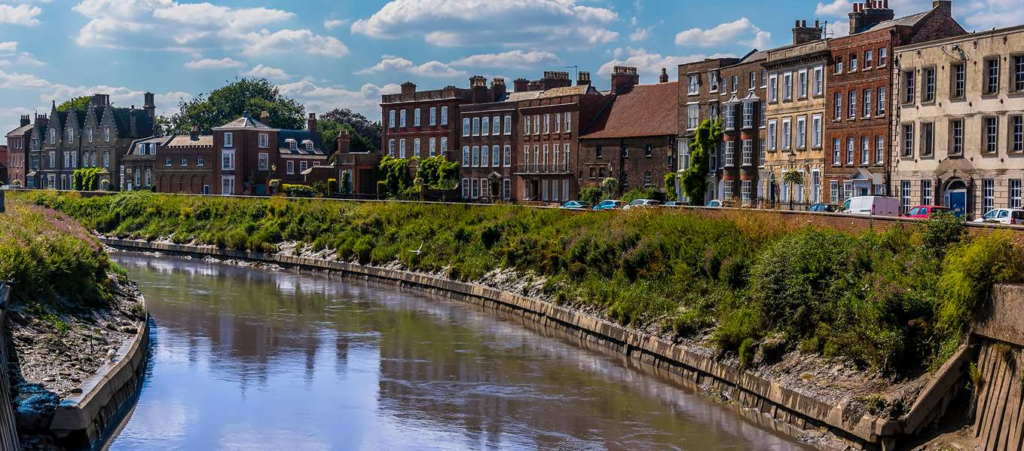
So much for Wisbeach, which stands upon the River Nene or Nen, which is the last of the towns defended by the old sea-wall — which is the third of the Fen ports — the other two being Boston and Lynn, which is served by two lines of railway and which has two stations.
Very early next morning, and by one of these stations, another man and I took train to a bridge called Sutton Bridge, where one can cross the River Nen, and where (according to the map) one can see both the sea-walls, the old and the new. It was my plan to walk along the shore of the Wash right across the flats to Lynn, and so at last perhaps comprehend the nature of this curious land.
When I got to Sutton Bridge I discovered it to be a monstrous thing of iron standing poised upon a huge pivot in mid-stream. It bore the railway and the road together. It was that kind of triumphant engineering which once you saw only in England, but which now you will see all over the world. It was designed to swing open on its central pivot to let boats go up the River Nen, and then to come back exactly to its place with a clang; but when we got to it we found it neither one thing nor the other. It was twisted just so much that the two parts of the roads (the road on the bridge and the road on land) did not join.
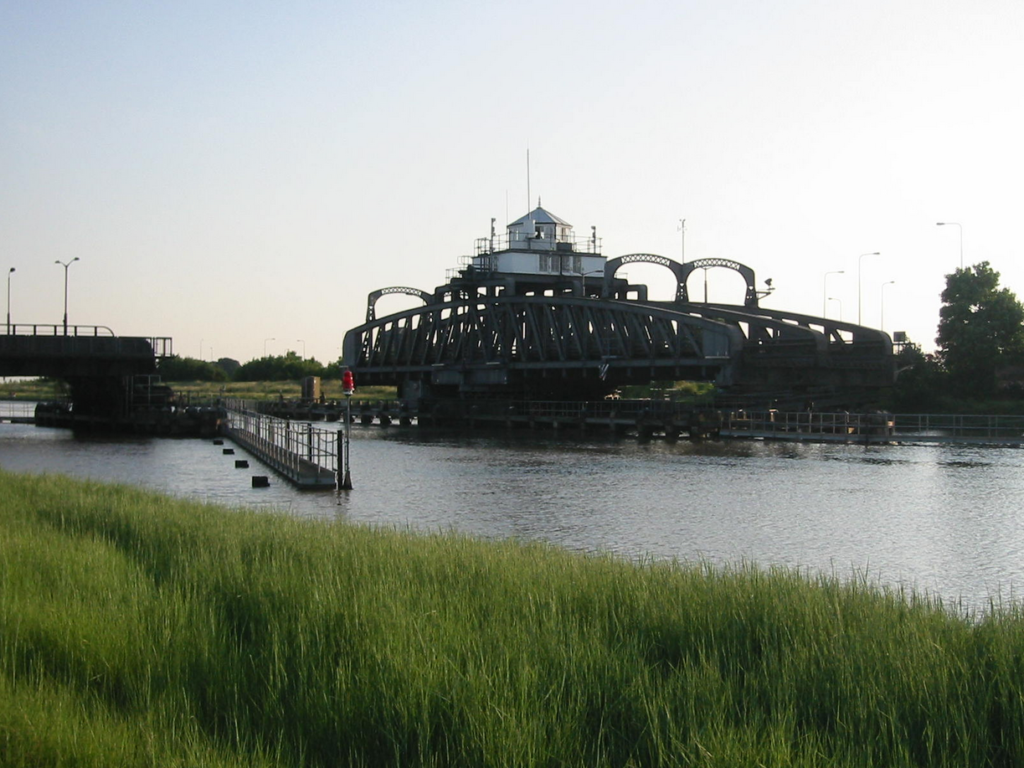
Was a boat about to pass? No. Why was it open thus? A man was cleaning it. The bridge is not as big as the Tower Bridge, but it is very big, and the man was cleaning it with a little rag. He was cleaning the under part, the mechanisms and contraptions that can only be got at when the bridge is thus ajar. He cleaned without haste and without exertion, and as I watched him I considered the mightiness of the works of Man contrasted with His Puny Frame. I also asked him when I should pass, but he answered nothing.
As we thus waited men gathered upon either side — men of all characters and kinds, men holding bicycles, men in carts, afoot, on horseback, vigorous men and feeble, old men, women also and little children, and youths witless of life, and innocent young girls; they gathered and increased, they became as numerous as leaves, they stretched out their hands in a desire for the further shore: but the river ran between.
Then, as being next the gate, I again called out: When might we pass? A Fenland man who was on duty there doing nothing said, I could pass when the bridge was shut again. I said: When would that be? He said: Could I not see that the man was cleaning the bridge? I said that, contrasting the bridge with him and his little rag, he might go on from now to the Disestablishment of the English Church before he had done; but as for me, I desired to cross, and so did all that multitude.
Without grace they shut the bridge for us, the gate opened of itself, and in a great clamorous flood, like an army released from a siege, we poured over, all of us, rejoicing into Wringland; for so is called this flat, reclaimed land, which stands isolated between the Nen and the Ouse.
Was I not right in saying when I wrote about Ely that the corner of a corner of England is infinite, and can never be exhausted?
Along the cut which takes the Nen out to sea, then across some level fields, and jumping a ditch or two, one gets to the straight, steep, and high dyke which protects the dry land and cuts off the plough from the sea marshes. When I had climbed it and looked out over endless flats to the sails under the brune of the horizon I understood the Fens.
Nowhere that I have been to in the world does the land fade into the sea so inconspicuously.
The coasts of western England are like the death of a western man in battle — violent and heroic. The land dares all, and plunges into a noisy sea. This coast of Eastern England is like the death of one of these eastern merchants here — lethargic, ill-contented, drugged with ease. The dry land slips, and wallows into a quiet, very shallow water, confused with a yellow thickness and brackish with the weight of inland water behind.
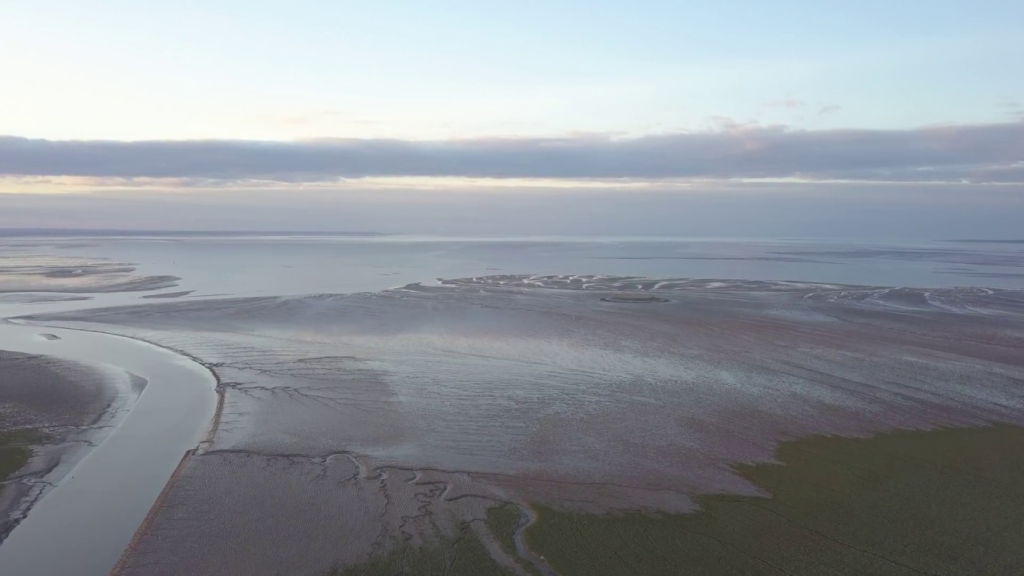
I have heard of the great lakes, especially of the marshes at the mouth of the Volga, in the Caspian, where the two elements are for miles indistinguishable, and where no one can speak of a shore; but here the thing is more marvellous, because it is the true sea. You have, I say, the true sea, with great tides, and bearing ships, and seaports to which the ships can go; and on the other side you have, inhabited, an ancient land. There should be a demarcation between them, a tide mark or limit. There is nothing. You cannot say where one begins and the other ends. One does not understand the Fens until one has seen that shore.
The sand and the mud commingle. The mud takes on little tufts of salt grass barely growing under the harsh wind. The marsh is cut and wasted into little islands covered at every high tide, except, perhaps, the extreme of the neaps. Down on that level, out from the dyke to the uncertain line of the water, you cannot walk a hundred yards without having to cross a channel more or less deep, a channel which the working of the muddy tides has scoured up into the silt and ooze of the sodden land. These channels are yards deep in slime, and they ramify like the twisted shoots of an old vine. Were you to make a map of them as they engrave this desolate waste it would look like the fine tortuous cracks that show upon antique enamel, or the wandering of threads blown at random on a woman’s work-table by the wind.
There are miles and miles of it right up to the EMBANKMENT, the great and old SEA-WALL, which protects the houses of men. You have but to eliminate that embankment to imagine what the whole countryside must have been like before it was raised, and the meaning of the Fens becomes clear to you. The Fens were long ago but the continuation inland of this sea-morass. The tide channels of the marsh were all of one kind, though they differed so much in size. Some of these channels were small without name; some a little larger, and these had a local name; others were a little larger again, and worthy to be called rivers — the Ouse, the Nen, the Welland, the Glen, the Witham. But, large or small, they were nothing, all of them, but the scouring of tide-channels in the light and sodden slime. It was the high tide that drowned all this land, the low tide that drained it; and wherever a patch could be found just above the influence of the tide or near enough to some main channel for the rush and swirl of the water to drain the island, there the villages grew. Wherever such a patch could be found men built their first homes. Sometimes, before men civic, came the holy hermits. But man, religious, or greedy, or just wandering, crept in after each inundation and began to tame the water and spread out even here his slow, interminable conquest. So Wisbeach, so March, so Boston grew, and so — the oldest of them all — the Isle of Ely.
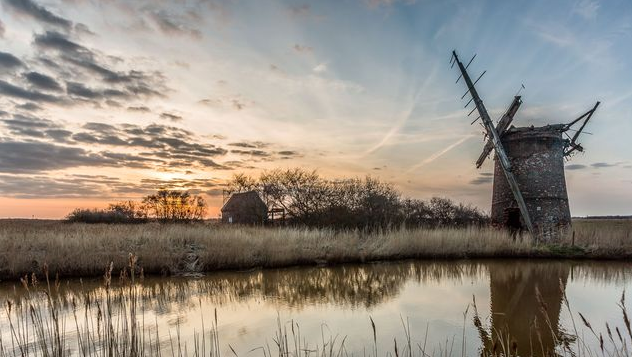
The nature of the country (a nature at which I had but guessed whenever before this I had wandered through it, and which I had puzzled at as I viewed its mere history) was quite clear, now that I stood upon the wall that fenced it in from the salt water. It was easy to see not only what judgments had been mistaken, but also in what way they had erred. One could see why and how the homelessness of the place had been exaggerated. One could see how the level was just above (not, as in Holland, below) the mean of the tides. One could discover the manner in which communication from the open sea was possible. The deeps lead out through the sand; they are but continuations under water of that tide-scouring which is the note of all the place inland, and out, far out, we could see the continuation of the river-beds, and at their mouths far into the sea, the sails.
A man sounding as he went before the north-east wind was led by force into the main channels. He was “shepherded” into Lynn River or Wisbeach River or Boston River, according as he found the water shoaler to one side or other of his boat. So must have come the first Saxon pirates from the mainland: so (hundreds of years later) came here our portion of that swarm of Pagans, which all but destroyed Europe; so centuries before either of them, in a time of which there is no record, the ignorant seafaring men from the east and the north must have come right up into our island, as the sea itself creeps right up into the land through these curious crevices and draughts in the Fenland wall.
Men — at least the men of our race — have made everything for themselves; and they will never cease. They continue to extend and possess. It is not only the architecture; it is the very landscape of Europe which has been made by Europeans. In what way did we begin to form this difficult place, which is neither earth nor water, and in which we might have despaired? It was conquered by human artifice, of course, somewhat as Frisia and the Netherlands, and, as we may believe, the great bay of the Cotentin were conquered; but it has certain special characters of its own, and these again are due to the value in this place of the tides, and to the absence of those natural dykes of sand which were, a thousand years ago, the beginnings of Holland.
Two methods, working side by side, have from the beginning of human habitation reclaimed the Fens. The first has been the canalisation, the fencing in of the tideways; the second has been the banking out of the general sea. The spring tides covered much of this land, and when they retired left it drowned. Against their universal advancing sheet of water a bank could be made. Such a bank cut off the invasion of the hundreds of runnels, small and great, by which the more ordinary tides that could not cover the surface had yet crept into the soil and soaked it through.
When such a bank had been built, gates, as it were, permitted the water to spend its force and also to use its ebb and flow for the draining of the land beyond. The gates which let the tide pour up and down the main ways became the new mouths of the main rivers; inland the courses of the rivers (which now took all the sea and thus became prodigious) were carefully guarded. Even before trenches were dug to drain the fields around, earth was thrown up on either side of the rivers to confine them each to one permanent channel; nor did the level of the rivers rise, or their beds gets clogged; the strength of the tide sufficed for the deepening of their channels. Into the rivers so fortified the other waterways of the Fens were conducted.
By these methods alone much of the land was rendered habitable and subject to the plough. Probably these methods were enough to make it all it was in the Middle Ages. It was only far later, almost in our own time, that water was gathered by trenches in the lowland beneath the rivers and pumped out artificially with mills; nor is it quite certain even now that this method (borrowed from Holland) is the best; for the land, as I have said, is above and not below the sea.
Of these works, whose tradition is immemorial, the greatest, of course, are the sea-walls.
Perhaps the river-walls came first, but the great bank which limited and protected the land against the sea is also older than any history.
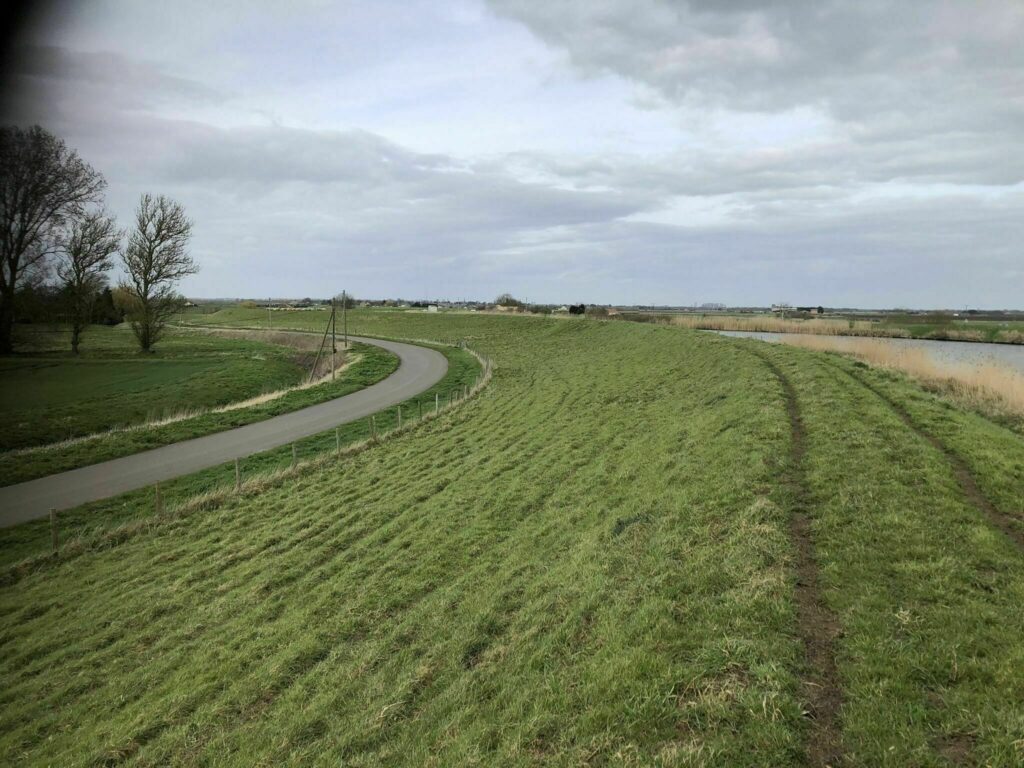
It is called Roman, and relics of Rome have been found in it, but it has not the characteristic of Roman work. It runs upon no regular lines; its contour is curved and variable. It is surely far older than the Roman occupation. Earth, heaped and beaten hard, is the most enduring of things; the tumuli all over England have outlasted even the monoliths, and the great defensive mounds at Norwich and at Oxford are stronger and clearer cut than anything that the Middle Ages have left. This bank, which first made Fenland, still stands most conspicuous. You may follow it from the Nene above Sutton Bridge right over to Lynn River, and again northward from Sutton Bridge (or rather, from the ferry above it) right round outside Long Sutton and Holbeach, and by Forsdyke Bridge and outside Swyneshead; everywhere it encloses and protects the old parishes, and everywhere seaward of it the names of the fields mark the newest of endeavours.
We returned from a long wandering upon the desolate edges of the sea to the bank which we proposed to follow right round to the mouth of the Ouse: a bank that runs not straight, but in great broken lines, as in old-fashioned fortification, and from which far off upon the right one sees the famous churches of the Wringland, far off upon the left a hint beyond the marshes and the sands of the very distant open sea.
A gale had risen with the morning, and while it invigorated the travellers in these wastes it seemed to increase their loneliness, for it broke upon nothing, and it removed the interest of the eye from the monotonous sad land to the charge and change of the torn sky above, but in a sense also it impelled us, as though we were sailing before it as it swept along the edge of the bank and helped us to forget the interminable hours.
The birds for whom this estuary is a kind of sanctuary and a place of secure food in all weathers, the birds swept out in great flocks over the flats towards the sea. They were the only companionship afforded to us upon this long day, and they had, or I fancied they had, in their demeanour a kind of contempt for the rare human beings they might see, as though knowing how little man could do upon those sands. They fed all together upon the edge of the water, upon the edge of the falling tide, very far off, making long bands of white that mixed with the tiny breaking wavelets. Now and then they rose in bodies, and so rising disappeared; but as they would turn and wheel against the wind, seeking some other ground, they sent from moment to moment flashes of delicate and rare light from the great multitude of their wings. I know of nothing to which one may compare these glimpses of evanescent shining but these two things—the flash of a sword edge and the rapid turning in human hands of a diaphanous veil held in the light. It shone or glinted for a moment, then they would all wheel together and it disappeared.
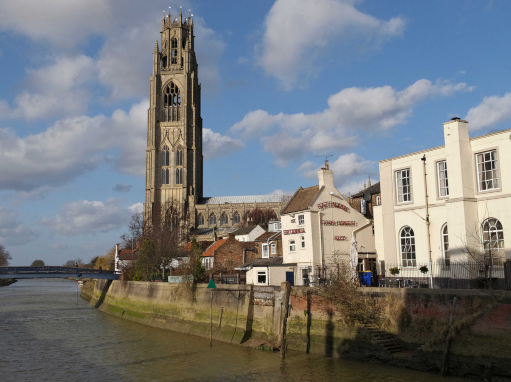
So, watching them as a kind of marvel, we saw distant across the sea a faint blue tower, and recognised it for Boston Stump, so many, many miles away.
But for the birds and this landmark, which never left us, all the length of the dyke was empty of any sight save the mixing of the sea and the land. Then gradually the heights in Norfolk beyond grew clearer, a further shore narrowed the expanse of waters, and we came to the river mouth of the Ouse, and caught sight, up the stream, of the houses of a town.

